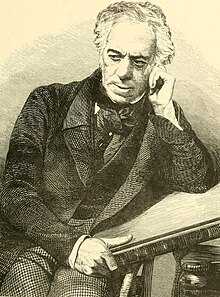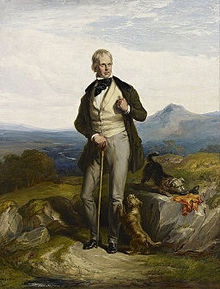William Allan (painter)
Sir William Allan | |
|---|---|
 | |
| Born | 1782 Edinburgh, Scotland |
| Died | 23 February 1850 (aged 67–68) |
| Known for | Painting |
Sir William Allan
Life and work

Allan was born in Edinburgh, the son of William Allan Snr., macer, an officer of the Court of Session. He was educated at the High School, Edinburgh, under William Nicol (1744?-1797), the companion of Robert Burns. Showing an aptitude for art, he was apprenticed to a coach-painter, and studied under John Graham at the Trustees' Academy, with David Wilkie, John Burnet, and Alexander George Fraser.[1] Here Allan and Wilkie were placed at the same table, studied the same designs, and contracted a lifelong friendship.[2]
After a few years he came to
Not finding success in London,
His wish to return home in 1812 had to be postponed due to the French invasion of Russia, many of the horrors of which he witnessed first-hand.[1]


Allan was able to return to Edinburgh in 1814, and, in 1815, his picture Circassian Captives attracted notice at the Royal Academy, though it did not find a purchaser. However, Sir Walter Scott, John Wilson (1785–1854) and his brother James (1795–1856), John Lockhart, and others, raised a lottery for it, with 100 subscribers at £10 10s. each, and the picture was won by Francis Wemyss-Charteris, 9th Earl of Wemyss. Allan remained in Edinburgh, and though his pictures (including Tartar Robbers dividing their Spoil) did not find purchasers amongst his countrymen, some of them were bought by the Grand Duke Nicholas when he visited Edinburgh, which resulted in a turn of fortune for the artist.[3] Allan afterwards painted some scenes from Scottish history suggested by the novels of Sir Walter Scott, such as Death of Archbishop Sharpe and Knox admonishing Mary Queen of Scots (exhibited in 1823 and engraved by John Burnet). Also of note were Mary Queen of Scots signing her Abdication (1824) and Death of the Regent Murray (exhibited 1825), which was purchased by the Duke of Bedford for 800 guineas, and gained the artist his election as an associate of the Royal Academy.[3]

In 1826 Allan was appointed master of the Trustees' School, Edinburgh, an office which he held until a few years before his death.
In 1832 Allan was living at 8 Scotland Street in Edinburgh's New Town.[4]
In 1834 he visited Spain and Morocco, and in the same year he produced The Orphan, which represented Scott's daughter Anne seated near the chair of her deceased father.[3] In 1835 he was elected a Royal Academician, and in 1838, on the death of Sir George Watson, was made president of the Royal Scottish Academy. In 1841 he went to St. Petersburg, and in the same year succeeded Wilkie as limner to the queen in Scotland, an office which was, as usual, followed (in 1842) by a knighthood.[1][5]
Sir William's later years were occupied with battle-pieces.
In his final years Sir William lived at 72 Great King Street, a substantial Georgian townhouse over five storeys, in Edinburgh's Second New Town.[6] He died of Bronchitis at his Edinburgh home on 23 February 1850.[7]
At the time of his death Sir William was engaged on a large picture of the Battle of Bannockburn.[1]
He is buried in Dean Cemetery in Edinburgh against the north wall of the original cemetery backing onto the late Victorian extension.[citation needed]
Works

- Russian Peasants keeping their Holiday (1809)
- Bashkirs (1814, Hermitage)
- Frontier Guard (1814, Hermitage)
- The Sale of Circassian Captives to a Turkish Bashaw (1816)
- Tartar Robbers dividing Spoil (1817, Tate Gallery)
- John Knox admonishing Mary, Queen of Scots (1823)
- The Regent Murray shot by Hamilton of Bothwellhaugh (1825, Woburn Abbey)
- The Black Dwarf (1827, National Gallery of Scotland)
- Hellespont(1831)
- Slave Market (1838, National Gallery of Scotland)
- The Signing of the National Covenant in Greyfriars Kirkyard (Edinburgh City Arts Centre)
- Heroism and Humanity (Robert the Bruce with soldiers) (1840 Kelvingrove Museum)
- The Recovery of the stolen Child (1841, Aberdeen, art gallery)
- Battle of Prestonpans (1842, private collection)
- Peter the Great teaching his Subjects the Art of Shipbuilding (1845, formerly in the Winter Palace of the Hermitage, now lost)
- Waterloo, 18 June 1815 (1843, His Grace Valerian Wellesley, 8th Duke of Wellington, Apsley House)
- The Duke of Wellington – en route to Quatre Bras (1844, private collection)
- The Battle of Waterloo (1845, Royal Military Academy Sandhurst)
- Battle of Bannockburn (Royal Scottish Academy, on loan to the Wallace Monument, Stirling)
See also
References
- ^ a b c d e f g Monkhouse 1885.
- ^ a b Chisholm 1911, p. 687.
- ^ a b c d Chisholm 1911, p. 688.
- ^ "Edinburgh Post Office annual directory, 1832–1833". National Library of Scotland. p. 4. Retrieved 16 February 2018.
- ^ London Gazette, 3 June 1842, page 1504.
- ^ Edinburgh and Leith Post Office Directory, 1849
- ^ Tait's Edinburgh Magazine March 1850
Attribution:
 This article incorporates text from a publication now in the public domain: Monkhouse, William Cosmo (1885). "Allan, William". In Stephen, Leslie (ed.). Dictionary of National Biography. Vol. 1. London: Smith, Elder & Co.
This article incorporates text from a publication now in the public domain: Monkhouse, William Cosmo (1885). "Allan, William". In Stephen, Leslie (ed.). Dictionary of National Biography. Vol. 1. London: Smith, Elder & Co.- This article incorporates text from a publication now in the public domain: Chisholm, Hugh, ed. (1911). "Allan, Sir William". Encyclopædia Britannica. Vol. 1 (11th ed.). Cambridge University Press. pp. 687–688.
Further reading
- ISBN 978-0-8014-9217-4.)
{{cite book}}: CS1 maint: location missing publisher (link - Allan, William (June 1974). "Sir William Allan". Connoisseur. 186 (748).
- Gordon, Esme (1976). The Royal Scottish Academy of Painting, Sculpture & Architecture 1826–1976. Edinburgh.
{{cite book}}: CS1 maint: location missing publisher (link) - Lewis, Frank (1979). A dictionary of British historical painters. Leigh-on-Sea.
{{cite book}}: CS1 maint: location missing publisher (link) - Kennedy, Roisin A. (1994). The subject paintings of Sir William Allan (1782–1850). University of Edinburgh.
{{cite book}}: CS1 maint: location missing publisher (link) - Howard, Jeremy; et al. (2001). William Allan: artist adventurer. Edinburgh: City of Edinburgh Museums and Galleries.
